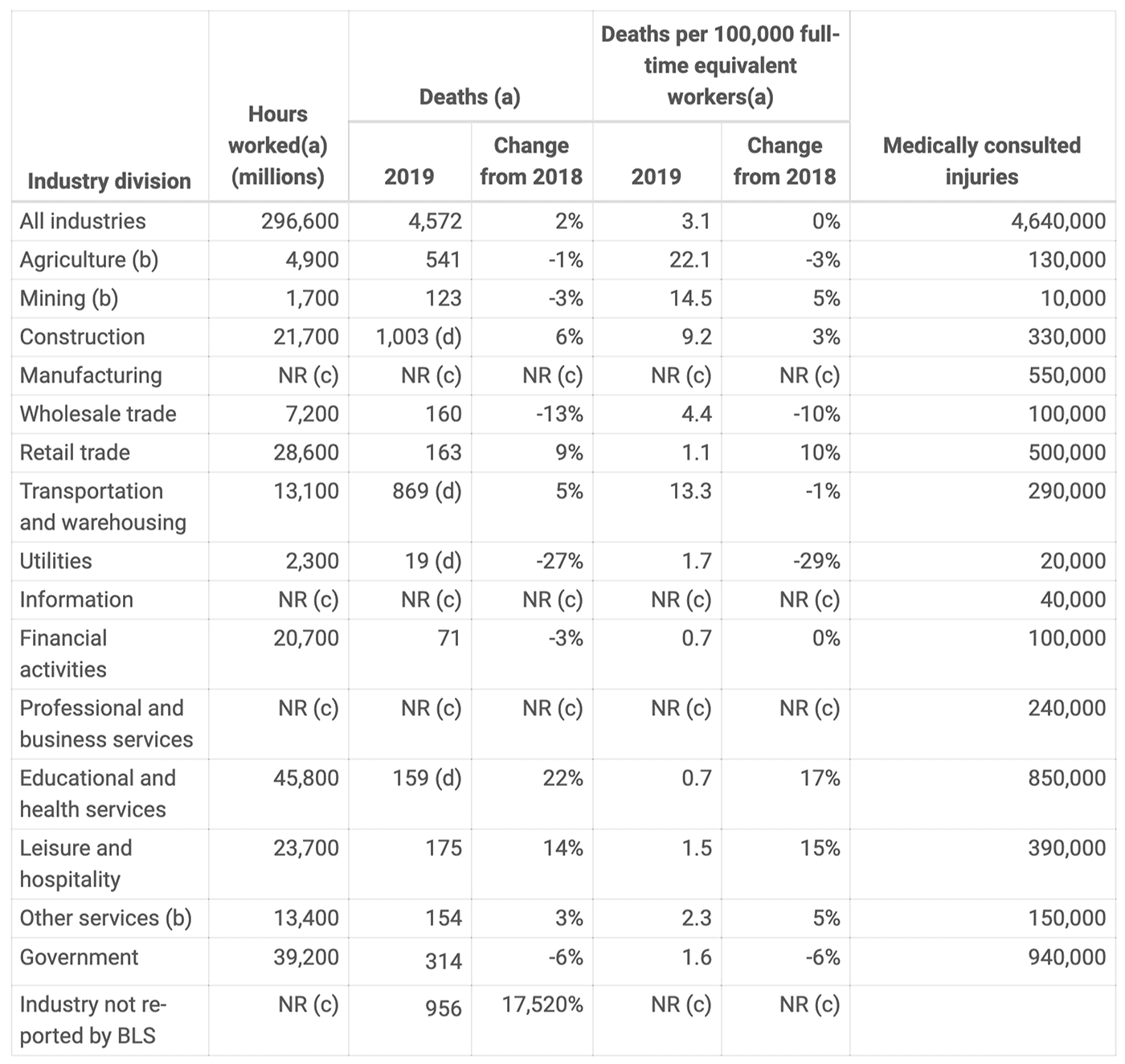
- How much do workplace injuries cost American businesses?
- What are the most common workplace injuries?
- Jobs that experience the most OSHA recordable events
- How can you lower the human and financial costs of workplace injuries?
If you’re a business owner, you are probably already aware of the high costs of workplace injuries. Having even one employee injured on the job is a crisis both from a human and financial perspective.
More than 540 workplace injuries occur every hour in U.S. businesses. These injuries result in 99 million days of lost job productivity each year; and while these numbers have been improving over the past decade, the costs associated with workplace injuries are simply staggering.
How Much Do Workplace Injuries Cost American Businesses?
The U.S. National Safety Council (NSC) reports that the direct financial costs of workplace injuries exceed $170 billion annually. OSHA cites a 2018 Liberty Mutual study stating employers paid more than $1 billion per week for direct workers’ compensation costs for non-fatal injuries in 2015.
What are the direct costs? They include:
- Workers’ compensation premium increases
- Medical expenses (for the employer and worker)
- Legal fees to defend against a lawsuit
The National Council on Compensation Insurance (NCCI) reports the direct costs of even one workplace safety incident on average is a minimum of $40,000 – but this is just the tip of a very expensive iceberg, as one must also consider the indirect costs.
Examples of indirect costs include:
- Accident investigation, safety assessments, administration and documentation
- Implementation of new training and corrective processes
- Lower employee morale, turnover, and absenteeism
- Possible OSHA fines and enforcement
- Productivity lost during a work stoppage associated with an injury incident
- Recovery of lost production with overtime pay, temp workers, reduced quality and scale
- Repairs of property or equipment
- Training replacement employees
One study found that for every $1 spent on direct costs associated with workplace injury, another $2.12 in indirect costs would accrue. Another study showed that the ratio between indirect and direct injury costs in the construction industry was 4:1 at minimum, and ran as high as 17:1.
Workplace injury affects much more than the injured worker. When you calculate the indirect costs, you’ll see that even one minor workplace injury has a substantially negative impact on the entire company. Workplace injury hurts the worker, company production, employee morale, impinges productivity, and severely impacts the bottom line.
Calculate Your Indirect and Direct Injury Costs
What Are the Most Common Workplace Injuries?
The most common types of injuries that result in time away from work are primarily musculoskeletal in nature. They include:
- Sprains, strains, and tears of ligaments, muscles, and tendons caused by overexertion
- Soreness or pain that often stems from chronic lower back issues
- Cuts, lacerations, fractures, and punctures is the third most common
Back and neck issues are a huge problem in all kinds of work environments, including remote workers who spend too much time in front of a computer screen.
Repetitive injuries are very common causes of workplace injuries. Repeated stress on joints and muscles can cause chronic illnesses to flare; and again, these are primarily related to the musculoskeletal system. This includes:
- Carpal tunnel syndrome is a repetitive injury common in office workers or those that work in industrial settings
- Tennis elbow isn’t just for tennis players; painters, tool or machine operators, and even dentists can develop this type of repetitive stress injury
- Inflammation-related injuries that flare up at work suddenly can include trigger finger (stenosing tenosynovitis) and tendonitis
The most common types of events or injuries that OSHA records are related to overexertion caused by repeated lowering, bending, squatting, and lifting. Being struck or caught by machinery is the second most common. Falling objects are always a hazard as well as crush injuries from a mishandle of heavy equipment.
Finally, common slips, trips, and falls cause a number of traumatic injuries, whether it’s sliding on a just-mopped floor or falling off a ladder. Concussions can occur more commonly than you probably realize, as do injuries to the back, hands, and legs on the job.

Jobs That Experience the Most OSHA Recordable Events
The occupations that experience the highest number of disabling injuries that cost the most and cause the most time off work include:
- Construction
- Service-related industries such as police, firefighters, and healthcare workers
- Transportation and shipping
- Manufacturing, industrial, and production
- Repair, installation, and maintenance
Preventable injuries at work by industry, United States, 2019
Source: National Safety Council
The construction industry is one of the most affected by on-the-job injuries. OSHA publishes a “fatal four” of construction hazards that often cause injury or death. This includes:
- Falls
- Electrical exposure
- Struck by objects
- Caught in machines or objects
OSHA also reports that of the 4,694 on the job fatalities in 2016, 21.1% were in the construction field. That translates to one in five worker deaths attributable to the construction industry alone.
How Can You Lower the Human and Financial Costs of Workplace Injuries?
Companies have a moral and fiscal responsibility to provide a safer working environment for their employees. R. Michael Greiwe, M.D., board-certified orthopedic surgeon and founder/CEO of OrthoLive Remote Injury Care says, “I feel like justice is a real theme around OrthoLive and everything we do. We want people to be treated the right way.”
Employers that implement successful safety prevention and on-site health management systems can significantly reduce preventable injuries and their human and financial outcomes. Many employers today are turning to video-based telemedicine as the go-to resource for a more effective workplace injury and safety infrastructure.
Video-based telemedicine uses the employee or safety manager’s digital device to connect a healthcare provider specializing in orthopedic injuries directly to the injured worker. These video-based telemedicine visits can provide the injured worker with immediate triage, diagnosis and treatment within minutes.
This kind of immediacy reduces the necessity of a trip to the ER in all but the most urgent of cases. This is a more appropriate response to the most common minor musculoskeletal injuries, including slips, sprains, repetitive motion and over exertion, or other simple problems that often wind up at the costliest point of treatment simply because there is no other option. Dr. Griewe says, “Then, as the employer, you get billed for some crazy amount that you can’t plan for. It’s not fair and I see this happen every day.”
Given that medically-consulted injury costs, on average, $39,000 per incident, having immediate access to clinical care can reduce the impact of these simple problems.
OrthoLive’s Remote Injury Care platform was designed by an orthopedic surgeon to improve our response to musculoskeletal injuries and care. We save employers up to 80% on the high indirect and direct costs of worksite injury.The technology, coupled with our network of experienced clinical providers, can help your business.




